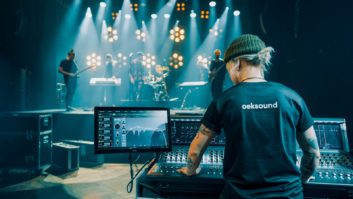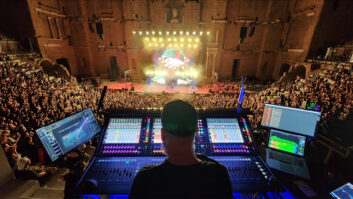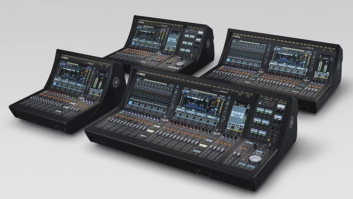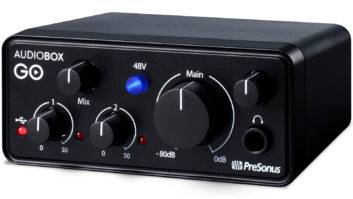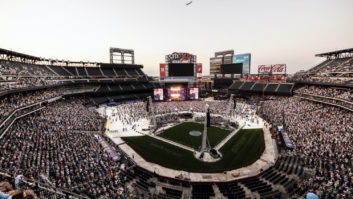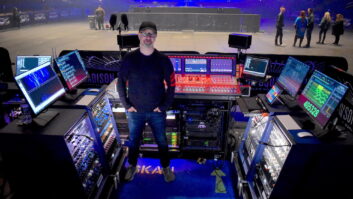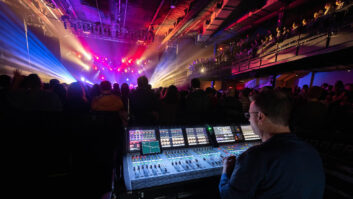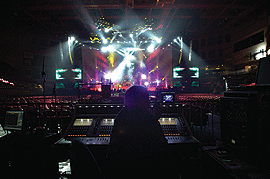

Once upon a time, live sound technology lagged behind new developments in studio gear. Part of this was simply budget-related. Another factor? Road life is tough on equipment, and with reliability being everything in the concert arena, choosing time-tested gear (i.e., Drawmer gates, dbx racks, etc.) typically meant that the show would go on. There were always a few exceptions — such as Frank Zappa using Neumann U47s onstage — but typically, studio and live equipment remained two distinct, highly segregated worlds.
But in the late ’80s/’90s, as the project studio movement grew, musicians began incorporating “studio” products into their signature sound. When these players went on the road, names such as Summit, Manley and Avalon showed up on riders and front-of-house effects racks. Front-of-house real estate was freed up somewhat with the arrival of digital consoles from Innovason, Yamaha and DiGiCo, with dynamics on every channel — and in the case of the Yamaha boards, full-on, digital effects/reverbs, as well.
Digidesign’s debut of the D-Show VENUE in 2005 brought ease of recording and access to third-party, software-based DSP plug-ins. Yet in this department, Digidesign is hardly the only game in town. Lawo’s new Plug-In Server brings plug-in ability to all of its digital consoles, while a just-announced Studer plug-in engine will bring VST effects capability to its flagship Vista 5 SR live board. ADK (Advanced Design of Kentucky) offers packages priced from about $5,000 to $10,000 that add plug-ins and simultaneous 56-track recording — typically on the Nuendo, Cubase, Samplitude or Reaper platforms, with support for outboard DSP plug-in cards such as those from Universal Audio, Waves and TC Electronic PowerCore — with mixers that can be MADI interfaced, such as DiGiCo or Yamaha digital consoles.
Photo: John Johnson
A different take on the “traditional” plug-in approach of using DSP programs that work with a variety of manufacturers’ gear — such as RTAS or VST — Yamaha offers various proprietary “Add-On” effects for its PM5D. First introduced for its DM2000 and 02R96, these software-based effects packages include channel strips, master strips (both loaded with vintage-style EQs and compressors), reverbs, stomp boxes and even surround 5.1 post effects.
And owners of analog consoles — i.e., Midas XL4s, Yamaha PM4000s, etc. — need not be left out of the fun. Popular in musicians’ racks onstage for running virtual instruments, the $1,999 Receptor from Muse Research also lets users load multiple VST plug-ins (including Antares’ Auto-Tune 5) into a two-rackspace host. In addition to low-latency performance from its onboard Linux engine, Receptor features balanced analog I/Os, S/PDIF I/O and ADAT Lightpipe outs, and offers manual or automated control from its front panel, remotely from a desktop/laptop Mac or PC, or via a local mouse/monitor/keyboard.
Today, multiple racks of gear at the house position are fast disappearing. Advantages of this include a smaller FOH footprint (equating to valuable space in shows where a single seat might go for $200) and reduced costs of cartage/shipping/trucking — a growing concern in the age of $5-per-gallon diesel.
There’s no doubt that plug-ins have brought the “re-create the album live” concept to a new level; for those plug-ins that are available live, parameter settings used in the studio can be stored and imported for the stage show. Another much-appreciated perk of using plug-ins — cited by numerous engineers — is the ease of auditioning a plug-in to see if it “fits” any particular show. This requires little more than downloading a time-limited demo version that can be purchased later, if need be.
However, the use of plug-ins in live sound does present downsides and occasional pitfalls. To get a real-life assessment of the situation, we talked to some top touring FOH engineers who’ve made the move to the plug-in world.
DIVE RIGHT IN
The transition to plug-ins can require a “breaking-in” period. Brad Madix, who is currently mixing FOH for Rush, began using Digidesign VENUE on last year’s Shakira tour. “I wasn’t really a Pro Tools guy back then, although I knew enough about it to be dangerous,” he says. “I’ve learned quite a bit about it since. Using VENUE took some getting used to, but the platform is intuitive — they’ve tried to lay it out more like a mixing desk rather than just trying to bus things around on a computer.”
John Ashton came off mixing house on the recent Arctic Monkeys tour to focus on his successful career as a solo artist and spend time as keyboardist with the Last Shadow Puppets. “In early 2007, I switched to the D-Show, and the transition period was barely noticeable — probably because I’d been using Pro Tools in my — ahem — ‘studio’ for years,” he notes, emphasizing the small “project” nature of his facility. He was no stranger to digital boards, having previously used InnovaSon and DiGiCo mixers and analog Midas XL4s and H3000s. “But my head was turned with the D-Show’s multitrack recording capabilities and simplicity. I tried it. It ticked all the boxes, so I stuck with it for a while.”
After two-and-a-half years on the road mixing The Fray, Mark Maher has the summer off — a rare luxury for touring pros — while the band records. But Maher, who previously mixed on PM5D and XL4 consoles, remembers the move to virtual. “I already knew Pro Tools, so using VENUE was just like doing a recording session mix, but live. Before we were in pre-production, the sound company, Eighth Day Sound, sent a system and console to my house so I could set up scenes and get ready for the tour — without the band even being there. And having that time to fine-tune the compression and gates — working from actual performance files — was amazing. This ability is one of the most important things to have happened in live sound in a long time.”
Yet he also injects some reality into the equation. “On some fly dates in Europe, we’d show up and I’d plug my card into the VENUE,” Maher continues. “Sometimes it would work perfectly; sometimes I’d have to tweak some things, but being able to stick in that card and be ready to go in five minutes was nice. Being so limitless with plug-ins is really mind-blowing, compared to where we were six or seven years ago. And recording every night to Pro Tools was so easy. For soundchecks, I’d play back the multitrack session, and if I wanted to, I could just listen to hi-hat for five minutes.”
Keith Urban’s FOH mixer, Stephen Law, got into digital consoles by accident. Just before one show, a cameraman moved a tarp, dumping 10 gallons of water into his Midas Heritage 3000, trashing half of its channels and disabling the automation, leaving the board with no fader control. After some clever patching and creative use of the working subgroups, he managed to get through the show.
The next day, the only replacement mixer available was a DiGiCo D5, which he ended up keeping for five years. “It’s a great console that never crashed,” says Law, who later added an ADK rack with RME MADI cards for recording and plug-in access. “My UAD-1 card has great analog emulations of LA-2As and 1176s, which I like, along with its Pultecs and Fairchilds.” Recently, Law switched to the new Studer Vista SR, a desk that he says is “sonically amazing, with great analog-sounding preamps.” He’s now using the Studer with the onboard Classic Dynamics package but looks forward to checking out the company’s new plug-in engine — which will add VST access — when it ships. Meanwhile, he’s using a hardware Lexicon 960L (4-in/8-out) for reverb and effects, but adds that the unit’s “digital I/O is great, so there are no conversion delays, although latency is much less of a problem when you’re dealing with reverbs or ambience effects.”

THE VIRTUAL SOUNDCHECK
Recording the show and playing back the previous night’s performance as a means of virtual soundchecking is nothing new. In fact, savvy FOH mixers had done this for years, going back to the days of MDMs, hauling a rack of ADATs or DA-88s around to do the deed.
But a DAW at FOH opens new possibilities. On the Shakira tour, Madix recalls that many of the same plug-ins from the album were available for the tour, “so when using Amp Farm to get the bass sound, I loaded in the same preset used on the record, which saved a lot of time. It completely changed the way I worked in rehearsals. I still listened to individual inputs, played with mic placement/selection and tried different Dis, but during rehearsals I was essentially tracking the band, so after they’d gone I could switch to playback and loop certain parts of a song and really home in on something like setting different bass presets from song to song.
“This level of detail would have been almost impossible while the band is going through the material and trying to learn the set,” Madix continues. “It also allowed Shakira and her musical director [MD] to be in the room with me afterward, making the mix a more collaborative process. Rather than just handing somebody a CD of a board mix and getting comments later, there’s nothing like sitting in a room with the artist and/or MD and being able to go through the live mixes and fix things while you’re there. We got mixes that Shakira liked very quickly, including trying out different plug-ins on her voice. For example, she had very specific ideas about spin-off delays — not only with the length, but also the sound of the delays. Also, during rehearsals, playing back actual album sessions [through the console] let me play with the plug-ins in a more realistic situation than simply having the drum tech hit the snare.”
That same technique worked on the Rush tour. “Neil Peart hits his drums in a very distinctive way,” Madix explains. “I’ve become a fan of the [Crane Song] Phoenix tape-emulation plug-in, which gives a certain nonlinearity that’s like bouncing something off tape. I put it across all of Neil’s drums and there’s no substitute for listening to him play while I’m fiddling all those knobs to get it just right because nobody else can hit those drums in exactly that same way.”
ERGONOMICS—GOOD AND BAD
After more than three decades of FOH mixing, David Morgan just can’t stop. Currently doing James Taylor’s full-band tour, he also mixes for Bette Midler, Paul Simon and other top acts. Formerly an analog console holdout, Morgan migrated to the Digidesign platform two years ago and likes it.
“People ask me all the time whether I’m bringing along Graces or other high-end preamps, but I’m not. I think the real art of warming up the sound is in the plug-ins,” Morgan says. “I have no problem with the Digi preamps and front end. For me, the two main prerequisites were whether the technology sounded good and whether the interface gets in the way of being a member of the band. You’ve got a large monitor right in front of you, in your view of the stage, and everything is accessible up high — you don’t have to look down on the desk to find something. It’s easy when you only momentarily have to divert your eyes away from the screen to see what’s going on onstage. You can’t mix a good show without paying attention to what the musicians are doing onstage. You have to be part of the show.”
For Maher, the digital console/plug-in approach has pluses and minuses. “When you go back to, say, an XL4, it reminds you just how good it can sound, but with digital there’s definitely a lot of ease of use,” he says. “But mixing on an analog console, when you hear certain things during the show, your hand instinctively goes to that EQ knob to pull down that low-mid that sounds a little funky. Yet with digital, you might have to press three buttons to get there. It’s not that you become lazy, but you might let certain things go by that you would have tweaked in analog.”
There are other plug-in complications, as well. “Early in the [Rush] tour, I was using the Waves SSL console bundle, which I loved, yet there were some conflicts with that and VENUE,” Madix explains. “Eventually, I’m sure this will be resolved, but it’s always been an issue with digital, where hardware and software leapfrog each other or an OS changes. It’s part of the game, but keeping track of what works with what can gets complicated these days.”
THE PLUG-IN ADVANTAGE
“This is the first tour where I’m going all-digital, from the input to the output of the crossovers,” Madix says. “Right after the signal’s converted at the head amp onstage, it’s dig’ all the way, including the input of the crossover, which is an AES input. I’m not trying to be a purist about it, because it was a challenge to do and there are certain pieces of gear that I haven’t got a plug-in substitute for, but software emulations are getting better all the time.”
“Using plug-ins definitely leads to better shows for me; it’s an eye-opener,” says Morgan. “As someone who was exclusively analog until about two years ago, the change is a refreshing and welcome addition to my life. I can produce quality audio on a digital console. I’m really excited about the possibilities and with other breakthroughs — like the Lake Audio stuff and these beautiful line array systems that keep getting smaller and better sounding. As I approach my 60th birthday next year, I’m more enthusiastic about mixing than I’ve ever been. The whole process is becoming more facile and enjoyable.”
The use of software plug-ins in live sound is still in its early stages, so the story’s far from over. Yamaha is no stranger to the realm of signal processing and its digital consoles are a major force in live sound mixing. The company owns Steinberg, so would a co-venture with these same developers who brought us Cubase, Nuendo and VST really be far-fetched? Meanwhile, DiGiCo is reportedly negiotiating licenses to open the architecture of its consoles. That system is Windows-based, and loading some cool new effects directly into your D5 or SD7 may be a reality in the not-too-distant future. Stay tuned.
George Petersen is Mix‘s executive editor and runs a small record label at www.jenpet.com.
ILOKS: THE FINE PRINT
One downside of software plug-ins is copy-protection schemes — typically, the $50 iLok key that carries user authorizations. On the plus side, engineers can simply show up at a gig, plug the iLok into a USB port and access all their fave plug-ins. Even in the worst possible scenario — disk crash, replacement system with no installs, etc. — copies of the programs can be loaded from CD/DVD-ROMs or downloads in short order, and the show goes on with the authorizations from your iLok.
However, this is not to say everything’s always rosy. “Coming back from a European tour, someone in airport security decided to empty my entire computer bag,” Morgan recalls. “Then, 15 minutes before I board, I notice my iLoks are gone. There are $40,000 worth of licenses on that iLok. I panic and sprint back to security where they had the iLok, the backup iLok and two USB drives with all my console settings. I was always told to keep an iLok backup in a separate place, but when you’re touring, what can you do? I’m not going to keep my iLok in my suitcase, which could wind up in Istanbul. So now we have something called ‘Do I have my iLok?’ panic, but, fortunately, the only thing I lost from that was an LED flashlight.”
Evidently, the condition is contagious. “I have nightmares about losing the iLok, especially since the tour manager lost his and all his other dongles,” Ashton confesses. “We discovered just how useless all these ‘protect your licenses/iLok replacement, blah, blah’ packages really are!”
Every FOH engineer has experienced that “left my walk-through music CD in the player at the last venue” feeling, but the situation is far more serious with an iLok. “The nice thing about an iLok is that once the desk is turned on, you can pull it out,” says Madix, offering his solution. “I have a lanyard on mine and keep it around my neck. I carry four iLoks for different purposes, but I can only imagine what a company like Clair Bros. has to do to keep track of what’s installed on what desk or what authorizations go on what tour, moving them back and forth into their account. It’s a major juggling act on that scale.”
— George Petersen

READ: Must Play
Find out how other front-of-house engineers are using plug-ins in their mi
